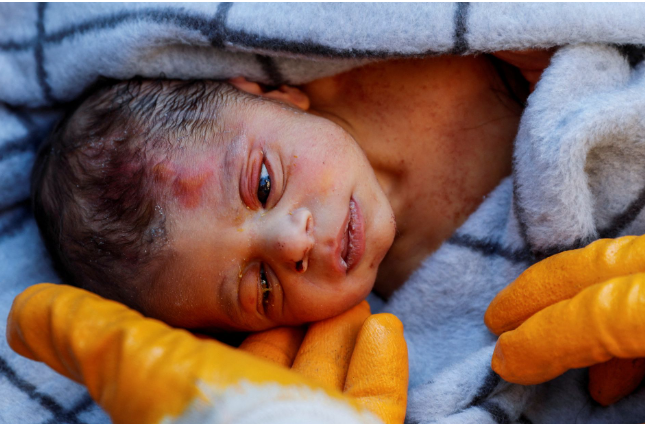
(Reuters) – Rescue crews on Friday pulled a 10-day-old boy and his mother from the ruins of a collapsed building in Turkey and dug out several people in other sites four days after a huge earthquake wrought death and destruction across southern Turkey and northwest Syria.
The confirmed death toll from the deadliest quake in the region in two decades stood at 21,000 in both countries on Friday.
Hundreds of thousands more people have been left homeless and short of food in bleak winter conditions, desperate for a multi-national relief effort to alleviate their suffering. Syrian President Bashar al-Assad made his first reported trip to affected areas since the quake, visiting a hospital in Aleppo, state media reported. But the World Food Programme said it was running out of stocks in rebel-held northwest Syria.
Turkey’s President Tayyip Erdogan was also expected to tour the disaster zone in his country on Friday amid criticism from survivors and political opponents that his government’s response to the catastrophe was slow and poorly organised – accusations he rejects as he bids for re-election in May. That election may now be postponed due to the disaster. In the Turkish city of Kahramanmaras, near the quake’s epicentre, Friday prayers echoed over the devastated area, mixing with the din of extractors and generators powering the rescue operations.
Rescuers, including teams from dozens of countries, toiled through the night in the ruins of thousands of wrecked buildings. In freezing temperatures, they regularly called for silence as they listened for any sound of life from mangled concrete mounds. In the Samandag district of Turkey’s Hatay province on Friday, rescuers crouched under concrete slabs and whispering “inshallah” (God willing), carefully reached into the rubble and picked out a 10-day-old newborn.
His eyes wide open, baby Yagiz Ulas was wrapped in a thermal blanket and carried to a field hospital. Emergency workers also took away his mother, dazed and pale but conscious on a stretcher, video images showed.
In Diyarbakir to the east, Sebahat Varli, 32, and her son Serhat were rescued and taken to hospital on Friday morning, 100 hours after the quake.
Across the border in Syria, rescuers from the White Helmets group used their hands to dig though plaster and cement until reaching the bare foot of a young girl, still wearing pink pajamas, grimy but alive and free.
But hopes were fading that many more would be found alive.
In the Syrian town of Jandaris, Naser al-Wakaa sobbed as he sat on the pile of rubble and twisted metal that had been his family’s home, burying his face in the baby clothes that had belonged to one of his children.
“Bilal, oh Bilal,” he wailed, shouting the name of one of his dead children.
The death toll from the 7.8 magnitude earthquake and several powerful aftershocks across both countries has surpassed the more than 17,000 killed in 1999 when a similarly powerful earthquake hit northwest Turkey.
It now ranks as the seventh most deadly natural disaster this century, ahead of Japan’s 2011 tremor and tsunami and approaching the 31,000 killed by a quake in neighbouring Iran in 2003. The death toll in Turkey rose to 18,342 by Friday morning and the number of injured stood at 74,242, the disaster management authority AFAD said.
In Syria, more than 3,300 have been killed, though rescuers have said many more people remain under rubble.
Some 24.4 million people in Syria and Turkey have been affected, according to Turkish officials and the United Nations, in an area spanning roughly 450 km (280 miles) from Adana in the west to Diyarbakir in the east. In Syria, people were killed as far south as Hama, 250 km from the epicentre.
Many people have set up shelters in supermarket car parks, mosques, roadsides or amid the ruins. Survivors are often desperate for food, water and heat, and working toilets are sparse in hard-hit areas.






